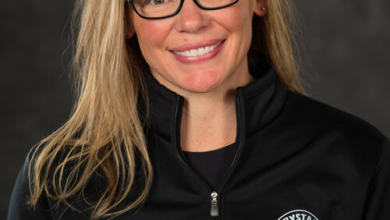Essential Summer Skincare Advice with Dr. Shari Lipner

Episode Transcript
Welcome to Health Matters – your weekly dose of the latest in health and wellness from NewYork-Presbyterian. I’m Faith Salie.
Summer is upon us and the sun is out, which means it’s time to protect ourselves from the sun!
I talked to Dr. Shari Lipner, a dermatologist at NewYork-Presbyterian and Weill Cornell Medicine, about some of the most common myths about the sun and sunscreen. She also shared some helpful tips on how to gauge if a mole could be a sign of something more serious and she gave some guidance on how to choose a sunscreen that works for you.
Faith: Dr. Shari Lipner, thank you so much for joining us.
Lipner: It’s great to be here. Faith.
Faith: I’d like to start,, as we enter these warmer, summer months. Can, can we start with your laying out for us some myths and misunderstandings about sun protection? Because I feel like there’s a lot out there.
Lipner: This is really a place where we need to educate the public. And, you know, our understanding of skin health and sun have has also changed over the years. So in terms of myths, you know, a lot of people believe that they don’t need sunscreen, right? That they don’t burn easily. And so if you don’t burn easily, you don’t need to protect from the sun and you don’t need sunscreen. Some people with darker skin colors also believe that they don’t need sunscreen because, you know, this is what was said, for many years, but we know now that everyone should be protecting themselves from the sun, and everyone should be using sunscreen because exposure to the sun in the long term, not just causes sunburns, but even if you don’t get a sunburn, it increases your risk of all three types of skin cancer and also causes skin aging.
Faith: So something I’ve always wondered about is vitamin D… do we need to expose ourselves to the sun to make vitamin D?
Lipner: Yeah. So for for many years people believed that they needed to go out in the sun to get their required vitamin D.
Faith: Right.
Lipner: And that’s a myth because too much exposure to the sun unprotected can lead to skin cancers and skin aging. So what we recommend now for all people is to protect yourself from the sun. Use sunscreen. And if you’re deficient in vitamin D or your doctor wants you to, you know, increase your vitamin D intake, you can do that through diet and you can do that through supplements, but certainly don’t go lay out on your roof.
Faith: As people start spending more and more time outside in these months, what are your recommendations for how best to stay protected in the sun?
Lipner: There are a lot of simple measures that you can do to protect yourself from skin cancer and skin aging. Number one is to avoid the sun if you can during peak hours. And generally that’s between 10 and 2.
When you are out, it’s important to apply a sunscreen with broad spectrum protection, that’s water resistant, and we recommend an SPF 30. An SPF 30 will protect you from 97% of the sun’s rays. Now if you go up and up and up on your sunscreen and and go to a hundred, you’ll get a little more protection, but no sunscreen can give you a 100% protection. So you still have to be careful. You have to reapply sunscreen, particularly after being in the water or sweating. In addition to that, you should be wearing sunglasses, a hat with a broad rim, and, if you can, long sleeve or UPF clothing.
Faith: I have to say, Dr. Lipner, I am ready to embrace sunscreen. I’m a, I’m a very pale person. I have lots of moles. I know this is important, and yet more and more I hear that sunscreens are kind of dubious, so this whole sunscreen situation is very confusing.
Lipner: So I think there’s a lot of media play on this topic. I think it has created a lot of anxiety amongst the public. And we as dermatologists, you know, are trying to educate people about what this all means in terms of what the FDA has been saying in terms of what the media’s been saying. And I think I can simplify things.
The sun is a carcinogen. I mean, the sun is a known carcinogen, so we have to do everything we can to protect ourselves from sun exposure, which can lead to basal cell carcinoma, squamous cell carcinoma, and melanoma, which is a deadly, deadly skin cancer. And so it’s still important to use sunscreen. I think some of the controversy comes upon the fact that the FDA is still studying the ingredients in these sunscreens, but they have not said that they’re carcinogenic or that we shouldn’t be using them. They’re just studying further how the body absorbs these sunscreens. And there are two types of sunscreens.
There’s chemical sunscreens, and these include the ingredients like oxybenzone and evabenzone, and these chemical sunscreens act like a sponge and they absorb sunlight. And then there are the mineral sunscreens, which are zinc oxide and titanium oxide. And those, they block the sun’s rays, so they act a little bit differently.
The mineral sunscreens tend not to be as elegant going on, so they tend to leave a white film, which you know, may be unacceptable to some. But the FDA is still studying some of the ingredients in the chemical sunscreens. So I would say for people that don’t feel a hundred percent comfortable, they can use mineral sunscreens, but there’s no indication as of yet that chemical sunscreens are unsafe.
Faith: When SPF comes in moisturizers or makeup, you know, they’re tinted moisturizers, is that generally enough to protect us?
Lipner: Look, people put on usually about 25% of the sunscreen that they need. They don’t put on enough, and I think when people are putting on moisturizers or makeup, they’re putting on even less. So in general, I think. You know, if you’re just running out to your car, it’s probably fine, but if you’re really gonna be, you know, walking for more than 10 minutes, I think it’s better to put on a bonafide sunscreen.
Faith: Did I hear you correctly when you said, we use about 25% of the sunscreen we should be using?
Lipner: Yeah. People use sunscreen very, very sparingly. You know, in general, a shot glass is what you need to cover your whole skin. So, you know, just putting a little drop on your fingertips and thinking that’s gonna cover your whole skin. You know, because you don’t wanna have film showing or any white showing. I would say to err on the side of more rather than less in applying sunscreen.
Faith: Sun exposure is a known catalyst for skin damage, both, it can cause cancer. And you’ve mentioned that it can cause aging. Can you talk about how that works? What’s actually happening to our skin?
Lipner: So in terms of of skin aging, the UV rays can break down the elastic fibers and the collagen and that can cause wrinkles and can also stimulate some of the pigment producing cells called melanocytes and cause what we know as liver spots. In terms of the UVB rays and also some of the UVA rays, these rays cause DNA damage And this can lead to cancers by accumulating genetic mutations and DNA damage.
Faith: How does sun damage appear on the skin? How might it show up?
Lipner: So you may have dark spots on your skin, and these are known as solar lentigines. It can also cause premature wrinkles and it can also cause moles to appear or change, and certain changing moles, and those signs can be a sign of melanoma, which is the deadliest form of skin cancer. And the things we look for, it’s pretty easy to remember because we have a pneumonic called the A B C D E.
So A stands for asymmetry. So if you were to put a line through the mole, both sides should look the same as each other. And if they don’t, that’s a warning sign. Another warning sign is B for border, so it should be a nice round, smooth border. It shouldn’t be jagged or ragged or irregular.
C is for color. So tan light brown is fine, but moles that have multiple shades of brown, multiple colors or black, that can be a warning sign for melanoma. D stands for diameter. So we think of moles that are six millimeters as concerning. So think of a pencil eraser, a mole that’s bigger than a pencil eraser could be a cause for concern. And E is the most important one. I think E stands for evolving. So you have a mole that is changing, getting bigger, you wanna show that to a board certified dermatologist.
Faith: How often should people be checking for moles?
Lipner: I think that’s very important. I think everyone should see a board certified dermatologist to get their moles checked, particularly those with many moles or a family history of skin cancer, but there are things that you can do as well in addition to protecting your skin. So it’s important for people to do self skin checks on a monthly basis.
So you should set an alarm on your phone once a month when you’re getting into the shower or when you’re getting out of the shower. Take note of your moles. I mean, obviously, you know, the back, or the buttocks, back of the legs is a hard part to check, but you can use a mirror to help you out. you can use a partner to help you out. That’s very important.
Faith: What are some key takeaways that you wanna share with our listeners about caring for their skin, especially in the sun?
Lipner: Caring for your skin doesn’t have to be complicated or take a lot, lot of time. I would recommend just like you brush your teeth when you wake up in the morning, put on a broad spectrum SPF 30 sunscreen before you go out for the day. Cover up your skin as much as possible with a hat, sunglasses, long-sleeved clothes if you can. And see a board certified dermatologist to check your skin annually and once a month when you’re getting out of the shower, check your skin for any changes.
Faith: You just made that sound so simple and manageable.
Lipner: I think it is simple. You know, I think, I think as long as people just make it part of their routine, it’s gonna be easy.
Faith: Dr. Lipner, thank you so much. Not only for demystifying a lot of this, but for shedding, shall I say, broad light on all of it.
Lipner: This was a lot of fun. Thank you. Faith.
Our thanks to Dr. Shari Lipner.
Health Matters is a production of NewYork-Presbyterian.
For more stories of science, care, and wellness visit healthmatters.nyp.org.
The views shared on this podcast solely reflect the expertise and experience of our guests.
NewYork-Presbyterian is here to help you stay amazing at every stage of your life.




